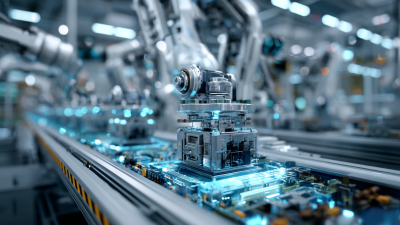In the rapidly evolving landscape of business operations, automation solutions are set to become the cornerstone of efficiency in 2024. As organizations worldwide strive for greater productivity and cost-effectiveness, the adoption of innovative automation technologies is unlocking unprecedented opportunities for growth and streamlining processes. This shift towards automation not only enhances operational workflows but also empowers employees to focus on strategic tasks, thereby driving creativity and innovation.

As we explore the future of automation solutions, it is crucial to understand how businesses can effectively implement these technologies to stay competitive. This guide will delve into the essential strategies and best practices for leveraging automation solutions, providing insights that can transform conventional workflows into highly efficient ecosystems. With the right approach, organizations can revolutionize their operations and position themselves for success in the near future.
As we step into 2024, the integration of intelligent automation is reshaping traditional business models, providing unprecedented opportunities for efficiency and agility. Organizations are increasingly adopting automation technologies that blend artificial intelligence with machine learning, enabling them to streamline operations and enhance decision-making processes. This shift allows businesses to allocate resources more effectively and focus on strategic initiatives rather than mundane tasks.

Tip: Start by identifying repetitive tasks within your organization that can benefit from automation. This will streamline operations and give your team more time to focus on innovation and growth.
Moreover, intelligent automation fosters a collaborative environment where humans and machines work in tandem. Companies that leverage this technological evolution witness improved customer experiences and quicker responses to market changes. Embracing these solutions ensures that businesses stay competitive while navigating the complexities of a rapidly evolving market.
Tip: Consider investing in scalable automation solutions that can grow with your business. Flexibility in automation tools will allow you to adapt to changing demands without disrupting your operations.
The future of automation solutions in 2024 is set to be driven by significant advancements in key technologies, particularly in the realm of Robotic Process Automation (RPA) and artificial intelligence (AI). According to industry reports, the global RPA market is projected to experience remarkable growth, with its market size surpassing $10.2 billion in 2023 and a robust annual growth rate forecasted around 7% through 2032. This increasing adoption is largely fueled by organizations seeking to enhance operational efficiency and minimize human error through automated processes.
Moreover, the decision intelligence market is also witnessing substantial expansion, with its anticipated value reaching $16.79 billion in 2024, and projected to grow to $57.75 billion by 2032. The fusion of RPA with AI technologies is particularly noteworthy, as it enables the automation of more complex tasks, thus transforming traditional workflows. Case studies released by various industry analysts highlight innovative implementations of RPA and AI, showcasing successful applications that significantly optimize business processes. As businesses prioritize digital transformation, these technologies are poised to revolutionize operational paradigms across various sectors.
This bar chart illustrates the anticipated growth in various automation technologies in 2024, showcasing their impact on business efficiency.
The integration of AI and robotics in the workplace is rapidly reshaping how businesses operate, providing unprecedented opportunities to enhance workforce productivity. In 2024, companies are expected to leverage intelligent automation to streamline repetitive tasks, allowing employees to focus on strategic initiatives. This shift not only increases efficiency but also boosts employee morale, as workers are relieved from mundane responsibilities and empowered to engage in more meaningful work.
Moreover, the collaboration between humans and machines will redefine job roles and skill requirements. Organizations will need to invest in training programs that equip employees with the knowledge to work alongside advanced technologies. This partnership between AI-driven automation and the human workforce will foster a culture of innovation, driving businesses to adapt quickly to market changes while maintaining a competitive edge. The future of work is not about replacing humans; it’s about enhancing their capabilities and creating a more agile and productive environment.

As businesses increasingly turn to automation solutions to enhance operational efficiency, the path to successful implementation is fraught with challenges that vary across industries. One significant hurdle lies in the integration of automated systems with existing workflows. Companies often face resistance from employees who fear job displacement or are reluctant to adapt to new technologies. Overcoming this cultural barrier requires effective change management strategies, including comprehensive training programs that emphasize the collaborative potential of automation to augment human capabilities rather than replace them.
Moreover, the complexity of compliance and regulatory requirements across different sectors can complicate the automation journey. Industries like healthcare and finance face stringent regulations that necessitate meticulous attention during the implementation of automated systems. Businesses must navigate these legal landscapes carefully, ensuring that their automation solutions not only streamline processes but also adhere to all relevant standards. By prioritizing transparency and collaboration with stakeholders, organizations can mitigate risks and cultivate a more conducive environment for embracing automation.
As we approach 2024, the global retail automation market is set to reach a staggering $24.36 billion. This rapid growth is projected to continue, with estimates suggesting an increase to $27.65 billion by 2025 and a remarkable $64.09 billion by 2032. Such figures highlight the transformative potential of automation solutions in shaping business strategies and operations. Companies are increasingly recognizing the necessity of integrating advanced technologies to enhance efficiency and improve customer experiences.
To stay ahead in this evolving landscape, businesses must embrace the future trends outlined in the '2025 Frontiers Technology Trends' report. Among these, artificial intelligence and generative AI stand out as pivotal players in redefining operational frameworks and driving innovation. The insights derived from this report emphasize a collaborative future where human intelligence and technology co-create solutions, ushering in an era of unprecedented productivity.
**Tips:** To leverage automation effectively, companies should start by assessing their current processes to identify areas ripe for improvement. Integrating automation in areas like inventory management or customer service can yield significant time and cost savings. Moreover, engaging with emerging technologies, such as machine learning and robotics, can further enhance operational efficiencies and provide a competitive edge in the marketplace.
| Automation Type | Impact on Business Efficiency (%) | Estimated Cost Savings ($) | Implementation Time (Months) | Adoption Rate (%) |
|---|---|---|---|---|
| Robotic Process Automation | 45 | $300,000 | 6 | 70 |
| AI-Powered Analytics | 50 | $250,000 | 4 | 65 |
| Chatbots and Customer Support Automation | 40 | $150,000 | 3 | 75 |
| Supply Chain Automation | 55 | $400,000 | 8 | 60 |
| Document Management Automation | 35 | $100,000 | 5 | 50 |





